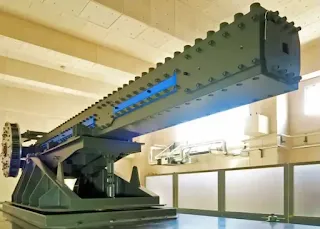Abstract
Table of Content
- Abstract
- History and Inventor of Railgun
- History of Railguns in Military Use
- Advantages of Railguns in Military Use
- Types of Railguns in Military Use
- Potential Military Applications of Railguns
- Challenges in Implementing Railguns in Military Use
- Why Railguns are Dangerous ?
- Comparisons with Other Military Weapons
- Ethical Considerations
- Conclusion
History of Railguns in Military Use
 |
| Credits to - Flickr(Office of Naval Research) |
Advantages of Railguns in Military Use
Railguns have a number of advantages over traditional firearms and missiles. I am nothing them as below as follows :- One of the biggest advantages is their ability to launch projectiles at extremely high speeds, allowing them to travel great distances with precision accuracy.
- Railguns also have a very flat trajectory, meaning that they can hit targets at long range with a high degree of accuracy.
- Another advantage of railguns is that they do not require explosive propellants, which can be dangerous and difficult to store and transport.
- Finally, railguns can be used to launch a variety of projectiles, including solid shot, guided projectiles, and even directed energy weapons.
Types of Railguns in Military Use
There are two main types of railguns that have been developed for military use: Single-stage and multi-stage railguns. Single-stage railguns use a single set of rails to accelerate the projectile, while multi-stage railguns use multiple sets of rails to gradually increase the speed of the projectile. The power requirements for multi-stage railguns are much higher than for single-stage railguns, but they can achieve much higher velocities. There are also different approaches to powering railguns, including using high-energy capacitors, batteries, or even nuclear reactors.Potential Military Applications of Railguns
There are a variety of potential military applications for railgun and yes, I am noting them as follows :- One of the most promising applications is in anti-ship and anti-aircraft defence. Railguns can launch projectiles at extremely high speeds, allowing them to penetrate the armour of even the most heavily armoured ships and aircraft.
- Railguns can also be used in ground-based artillery, providing long-range precision targeting with a flat trajectory.
- Finally, railguns can be used as anti-personnel weapons, launching projectiles at high speeds to incapacitate or kill enemy soldiers.
Challenges in Implementing Railguns in Military Use
There are several challenges that are faced while implementing railguns in military applications and here they are :- One of the biggest challenges is the high power requirements of railguns. Railguns require large amounts of electrical power to operate, which can be difficult to provide in a combat situation.
- Additionally, railguns generate a lot of heat, which can damage the rails and require cooling systems to prevent overheating.
- Finally, railguns require specialized equipment and infrastructure, which can be difficult and expensive to deploy in the field.
Why Railguns are Dangerous ?
 |
| Credits to : Flickr (HJ Media Studios) |
Another danger of railguns is their potential for collateral damage. The high velocity of the projectiles can cause them to pass through the target and hit unintended targets behind it, which can result in civilian casualties and other unintended consequences.
Comparisons with Other Military Weapons
Railguns are often compared with other military weapons,
such as conventional firearms, missiles, and lasers. Compared to conventional
firearms, railguns have a much longer range and higher accuracy. They also do
not require explosive propellants, making them safer and more reliable.
Compared to missiles, railguns are faster and have a flatter trajectory,
which allows them to hit targets at longer
ranges with greater precision. Railguns are also cheaper and more versatile
than missiles, since they can be used to launch a variety of projectiles.
So as compared to lasers, railguns have a much
longer effective range and can launch physical projectiles, which can be more
effective at penetrating armour and causing damage. However, lasers are more
precise and can be used to disable electronics and other sensitive equipment.
Ethical Considerations
As with any military technology, there are ethical considerations surrounding the use of railguns. One concern is the potential for railguns to cause collateral damage, since the high velocity of the projectiles could cause them to pass through the target and hit unintended targets behind it. There is also the potential for railguns to be used as weapons of mass destruction, since they could launch projectiles at high speeds with devastating effects.Conclusion
Railguns are a promising technology that has the potential to revolutionize military tactics and defence systems. They offer a number of advantages over traditional firearms and missiles, including longer range, higher accuracy, and greater versatility. However, there are also challenges and ethical considerations surrounding their use, and further research and development is needed to fully realize their potential. Overall, railguns are an exciting development in military technology, and their future applications and impact are sure to be closely watched in the coming years.P.S. : This article has been written much time before than my blog even existed. If there is any misinformation, please contact me using ‘Contact Us’ option and leave a comment below so that I can know that stuff and edit it.



